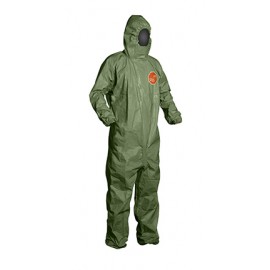CHEMICAL PROTECTIVE CLOTHING
PROTECTIVE CLOTHING
Protective clothing is clothing worn to shield those who work with
chemicals from the effects of chemical hazards that can cause injuries on the
job and other types
An important field of applications for
non-inflated fibre reinforced materials are different kind of safety suits and
hoods, which are to protect e.g. against chemical, biological or nuclear
hazards.
Naturally this kind of reinforced can be used as
water protecting suits, as raincoats and diving suits etc.
The
customer organisations for this kind of products may be for instance e mergency
services, military and general protection, nuclear or chemical industry,
pharmaceutical industry, food processing industry, medical services, hazardous
material handlers, or industrial safety authorities.
Types of Rubber Suits
A rubber suit is
available in many forms and types for varied uses ranging from industrial use
to sports, especially water sports needs to even rubber suits for weight loss
·
Rubber
Wet Suit- A rubber wet suit is
generally made of foamed neoprene rubber which is worn by water sports persons
like surfers, divers, windsurfers, canoeists etc. Accordingly, they are known
as rubber swim suit, rubber surf suit, rubber diving suit and so on.
This type
of rubber suit provides thermal insulation, abrasion resistance and buoyancy.
The insulation properties are dependent upon bubbles of gas enclosed within,
which reduce its ability to conduct heat.
·
Rubber
Dry Suit- A rubber dry suit
has more or less the same functions as those of wet suits. It also provides
thermal insulation to the wearer in water and is used by divers, boaters, and
other water sports persons. However there are certain differences between dry
suit and wet suit.
Dry suits prevent water to be entered into the rubber suit.
This leads to better insulation in dry suits making them more suitable for cold
water usage. However, dry suits can be very hot in warm or hot air.
·
Rubber
Rain Suit- As the name
suggests, the rubber rain suits are used for protecting the wearer from rain.
They are waterproof, windproof and are made up of lightweight and
breathable material
like PVC with other materials.
·
Rubber
Suits for Weight Loss- These are basically
rubber workout suits that are popular by such names as rubber sweat suit,
rubber sauna suit etc. They are claimed to promote sweating and burn calories
if worn while working out. As a result this type of rubber suit helps in weight
loss.
Industrial Rubber suits.
·
Industrial rubber
suits are worn as protective garments in industries and factories, especially
in chemical industry and mines. Traditionally, chemical-industry workers and
emergency workers commonly wear rubber suits made of butyl rubber which is very effective at blocking toxic
vapors or liquids.
·
But those rubber suits
had also drawback of trapping sweat, making them uncomfortable to wear for
anything more than mild physical exertion. To get rid of this problem, rubber
suits with liquid crystal molecule were manufactured. Even soldiers often rely
on a heavy, bulky rubber garment lined with activated carbon.
- This is a comfortable, compact shielding suit, which mixes together the rubber with liquid crystals which helps in obstructing harmful chemicals while letting sweat to go through, for people working in chemical industries or mines as well as emergency workers.
- · The liquid-crystal molecule, together with rubber generates petite particles that easily pass even through the small openings and impedes chemicals more efficiently than ordinary butyl rubber.
- · This new technology help producing protective suits which are also functional for cleaning unhygienic water and taking out the salinity of seawater as well.
- · There are also rubber suits laced with microscopic channels which could be used to make more comfortable, less bulky protective gear for people who work around hazardous environment.
- · Military personnel, chemical workers, and others could benefit from this new synthetic rubber material tailored with liquid crystals.
- The rubber material is used to make body suits to protect chemical-industry employees from skin exposure to toxic vapors and aerosols, and at the same time providing protection for military personnel and civilians in the event of a chemical-weapons attack.
- · The new composite is lightweight and breathable, but at the same time blocks the passage of toxic chemicals, reducing the risk of heat exhaustion in anyone wearing it.
- There are numerous standards, legislation and classifications on occupational health and safety issues, concerning the requirements for the safety suits and accessories. For instance, the American OSHA Standard calls for 4 levels of protection, A through D, and specifies in detail the equipment and clothing required to adequately protect the wearer at corresponding danger levels.
- The hazard type dictates the special requirements for the safety suit or attachment. The suits can be single use or reusable, or they can be positive pressure inflated to prevent the hazardous gase to intrude inside the suit. Various solutions for protective suits are based also on laminated multi-layer barrier films.
Level A represents the greatest danger of respiratory, eye or
skin damage from hazardous vapors, gases, particulates, sudden splash,
immersion or contact with hazardous materials. It calls for total encapsulation
in a vapor tight chemical suit with self-contained breathing apparatus (SCBA)
or supplied air and appropriate accessories.
Level B situations call for the highest degree of respiratory protection but a lesser need for skin protection. It calls for a positive pressure supplied air respirator plus hooded chemical resistant clothing (overalls and long sleeved jacket; coveralls; one or two piece chemical-splash suit; or disposable chemical-resistant coveralls.
Level C. Level C protection should be used when liquid
splashes or other direct contact will not adversely affect or be absorbed
through any exposed skin.





Protective coveralls suit
ReplyDelete